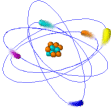
Fractal Research/Products
Artificial Leaves

 |
Fractal Research/Products Artificial Leaves |
 |
|
ARTIFICIAL LEAVES Artificial leaves, made from semiconductors, might one day help to remove excess airborne carbon dioxide and maybe even turn it into fuel. Real leaves, the green ones deployed by plants, perform many valuable tasks, not the least being the removal of CO2 from air and its replacement with breathable O2. Artificial CO2 fixation needs several ingredients: light, a catalyst (such as CdS), and organic molecules. A new study by a Oak Ridge-Vanderbilt team of physicists suggests how this process can be made more efficient, a necessary step if artificial fixation is ever to practical on a large scale. Contrary to previous ideas, the study shows, fixation does not take place directly on the catalyst surface. Rather it's a two step process: ionization of the CO2 occurs at the surface, creating a highly reactive radical which can later combine with other CO2 molecules or organic molecules in the vicinity.
|